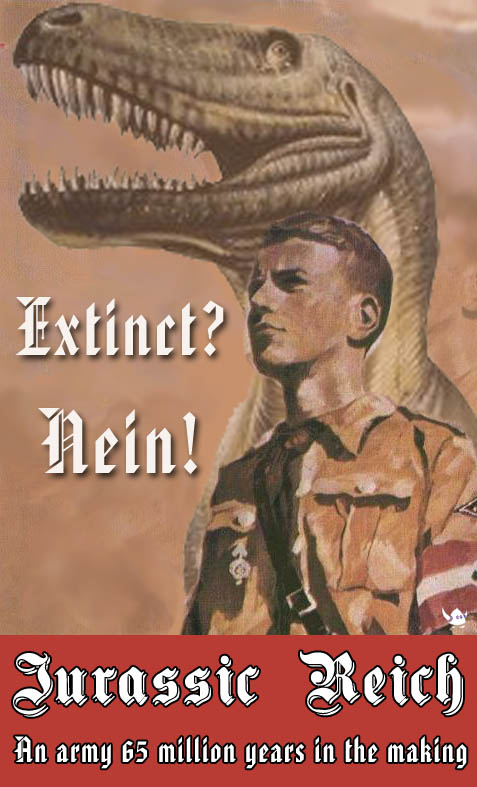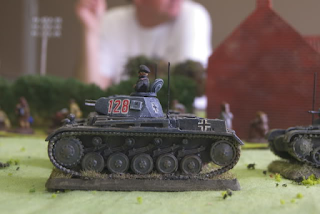I received two of the Warlord Testudo's for my birthday back in march, I actually finished these guys about three months ago but based them for WAB, since I am making the change to Impetus I re-based them and decided to take a pic!
Cheers
Matt
Monday, July 23, 2012
Tuesday, July 17, 2012
Jurassic Reich
enough, enough ...just off the painting table some of Andrews stuff for a upcoming Pulp game ....................set somewhere in South America
"Defend the Gap"
A few pics of the club ww2 game on the weekend, Boyd ran out his BEF (which is his latest project) along with some support from Ian's BEF and my Belgian Ardennes Rifles batn, and Greg used his 1940 German collection, the rest of the pics and a battle report will be on my ww2 blog Kampfgruppe Willow on the side bar.
impotent Pierre, who managed to fly over twice and not spot a thing........ I see nothing!!!!!
cheers
Matt
Labels:
20mm,
Goulburn Wargames Club,
Rapid Fire,
WW2
Friday, July 13, 2012
The Last Earl Of Montrose
The easterly mist covered the small village of Upper Wuthering, the quite of the dawn was broken with the sound of three armoured vehicles tearing along the hedgerow lined road, the car lights lite up the main village square as the vehicles screeched to a halt, ghostly figures set up a perimeter around one of the armoured cars. The people of these parts had seen very little of the troubles of the civil war being so far to the south west, quietly closed their blinds and quickly enter their cellars, hoping and praying that they would see the light of day once more...........
A tall dignified man exited the motor vehicle; it was none other than the James William Graham the Earl of Montrose, former peer and Navy Commander, his personal bodyguard stood by in full body armour and a large detachment of the CWAF (Coventor Women’s Auxiliary Force) had quickly taken up positions anxious and hoping their rescue would be on time as most of their vehicles were almost out of fuel.
Hot on their heels were the notorious Republic of Scotland (ROS) toughs lead by Captain Archibald Stuart Sinclair McPherson, tagging along was his best chum and adventurer Bertram Chudliegh Starkaddder leading the 6th coy of the Republic of Scotland Boy Scouts (ROSBC), like all ROS men they fancied loud bikes, trucks and big guns.
Just south of the Border the “Kings Own Scottish Borderers” (KOSB) received a phone call that a number of armed men had arrived in Upper Wuthering, The officer on duty young 1st Lt Ralph Fiennes-de Bohun decided that he would nip the trouble makers in the bud before they crossed the border and decided to investigate.
Turn three LMG and small arms fire sprayed out from the village some ROS and KOSB men are pinned, the scouts do some house decorating and clearing with grenades and the IRA men continue towards the tavern.
The sound of angry bees greeted the Kings Own Scottish Borderers as rounds from a LMG whizzed into their midst the KOSB needed to follow rules of engagement :lol: so they returned fire but could only engage targets they could see, several men were pinned the truck driver was fatally hit.
turn five
The IRA wins the all important initiative and enfilade the Coventor’s pinning most of the CWAF in the street, the KOSB head towards the cover of the buildings, the ROS continue firing but a number go down the ROSBC are caught in the open and are pinned.
To add to the confusion Captain Peter Sinclair arrives in the Warrnambool Air Leagues aircraft to see what all the fuss is about, he decides to strafe the street causing a lot of casualties among the CWAF and the Coventor’s. The IRA Lewis gunner decides to fire upon the plane and manages a engine hit, they want Montrose alive! The ROS and ROSBC decide to take cover in the buildings
The ROS and ROSBC decide retreat is a better type of Valour. The KOSB decide to start house clearing, two privates surprise Montrose but are gunned down, The remaining KOSB stay hiding. The CWAF are all killed in the crossfire and the remaining Montrose men flee into the buildings. The Covenanter’s rescue unit arrives on the edge of the table. Sinclair decides he had better head home
The IRA men occupy a Covenanter armoured car and decide to intercept the rescue squad and manage to stop them in their tracks. The remaining IRA members take Montrose alive and are last seen heading for the coast!
Figures
Cannon Fodder
Artizan
Musketeer
Bob Murch
Old Glory
Foundry
Hassel Free
Hinterland Miniatures
Vehicles
Sloppy Galopy
Company B
Various Matchbox diecast
plastic kits
bought to you by the Goulburn Valiant Stormers, Australia
cheers
Matt
Thursday, June 28, 2012
Scola Scutariorum Clibanariorum
Scola Scutariorum Clibanariorum
A Short History
The Scola Scutariorum Clibanariorum were part of the “Schola” or the Imperial Guard cavalry retinue, Each Schola was between 500 and 600 men. Many of the recruits for the Palatine troops were from barbarian tribes, Franks, Goths, Alans, Alamanni, Armenians and Isaurians. The Palatine troops were under command directly by the Emperor, the Magister Officiorum had direct control over the disposition of the Schola. Each Schola was commanded by a tribune who ranked as a Comes.By 400AD Scola Scutariorum Clibanariorum were part of the eastern Empire Army, according to the 'notitia dignitatum. The Scola Scutariorum Clibanariorum were present at the battle of Strasbourg/Argentoratum 357AD and they disgraced themselves by retreating when their commander was unhorsed (possibly Hormisdas who was a Persian) and several animals falling over in exhaustion.
This event is noted by both Ammianus, 16.12.37-41 and in the “Historia Nova” of Zosimus, at the battle of Strasbourg/ Argentoratum in 357 (HN 3.3.4-5):
And I ought not omit what Caesar did after this victory. "He had a troop of 600 horse, well trained in war, on whose strength and experience he so relied that he hazarded many of his hopes with them. When the battle began, the whole army fell upon the enemy with maximum enthusiasm so that the Roman army was gaining considerable advantage, but these alone broke ranks and fled, and even though Caesar himself and a few others rode after them and called them back to share in the victory, they would not have any part in the battle. Caesar was therefore very properly angry with them because, as far as they were concerned, they had abandoned their countrymen to the barbarians, but he did not impose on them the penalty defined by law; rather he dressed them in women's clothing and led them through the camp to expel them, thinking this a punishment worse than death for manly soldiers."
Dressed as women could refer to the removal of their military belts and being discharged as women so no land rights.
Concerning Cataphractarii and Clibanarii
I am not a believer that cataphractarii and clibanarii were one and the same. The first Roman Cataphract unit known is ala I Gallorum et Pannoniorum catafractata. The evidence we have for this unit is in a diploma dated 1st June 125 (when it was stationed in Moesia Inferior; it remained in that province until at least the late 150s).Both types appear in the Notitia Dignitatum and units of both types are included in a field army. The cataphracts are listed first, this I believe indicates that not only did they differ but the cataphractarii are the senior of the units. The difference, I suggest, lies in the way that they were equipped and mounted.
Western vs Eastern heavy cavalry
The Western type had their beginnings with Bosporan contarii , however the Roman type we are considering were introduced by the Sarmatian tribes. Both rider and horse were armoured; the man was armed with contus, bow and sword, and did not use a shield (Tacitus, Histories, 1.79). Tacitus calls the rider's armour catafractes and says that it was made from scales of horn or hard leather and was so heavy that the man had difficulty getting up when unhorsed. Trajan's Column shows Sarmatian cavalry with both horse and rider wholly covered with tight-fitting scale armor.
I have a theory to put forward that the Clibanariorum were mounted on the larger Nisean horses (which were larger than there western types and in bred on farms around Rome by this stage) with bronze scale armor (as horse sweat does not rust bronze and it polishes nicely) and that the men were armored head to foot, and armed with two handed Contus and the bow in the eastern style.
There was much discussion in the Roman Army Talk forum on whether clibanarii used shields or not. Certainly, the Parthian and Sasanian rock reliefs do not show their predecessors using them and Julian, in describing Constantius' clibanarii, states specifically that they did not need shields (Jul. Or. II, 57C) also I have a theory that the six Schola units of the Magister Officiorum only five shields are depicted on the Notitia Dignitatum, so perhaps the Scola Scutariorum Clibanariorum did not have them! (even though Scuta means shield!!!!)
A few Qoutes
Nazarius, Paneg., 24.5
What a spectacle that is said to have been, how dreadful to behold, how terrible, horses and men alike enclosed in a covering of iron.
Maxentius' clibanarii at the battle of Turin, AD 312.
Nazarius, Paneg., 24.5
When all had been killed to a man and your soldiers were untouched, people transferred the horror inspired by their armour to wonder at the victory . . .
Maxentius' clibanarii again.
Libanius, Oration XVIII, 18.37
. . . cavalry so invulnerably equipped as to lend them a terrible aspect . . .
Constantius' Scola Scutariorum Clibanariorum, AD 357.
Ammianus, 16.10.8
. . . all masked, furnished with protecting breastplates and girt with iron belts, so that you might have supposed them statues (simulacra) polished by the hand of Praxiteles, not men.
Scola Scutariorum Clibanariorum escorting Constantius on his entry into Rome, AD 357.
Claudian, In Rufinum II, 357-364
. . . the limbs within give life to the armour's pliant scales so artfully conjoined, and strike terror into the beholder. 'Tis as though iron statues (simulacra) moved and men lived cast from the same metal . . . each stands alone, a pleasure yet a dread to behold, beautiful yet terrible . . .
Rufinus' clibanarii, AD 395.
Cheers
Matt
Labels:
A and A Miniatures,
Eastern Roman,
Fall of the West,
IMPETUS,
Late Roman
Equites Sagittarii
Late Roman Equites Sagittarii
Again they are A and A miniatures, The sagittarii are quite versatile and could be used in any of my Fall of the West armies. I have based them for Impetus so the Equites sagittarii seniores and the Equites sagittarii iuniores look as though they are part way through a exercise known as the circulus cantabricus or Cantabrian circle, I am quite happy with the result!
Labels:
A and A Miniatures,
Eastern Roman,
Fall of the West,
IMPETUS,
Late Roman
Subscribe to:
Posts (Atom)



















































